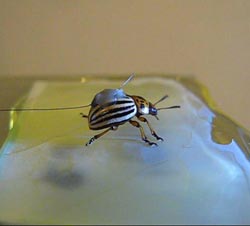Freiburg research team develops artificial surfaces insects cannot stick to

Source: Plant Biomechanics Group Freiburg<br>
Beetles, cockroaches, and ants will have a harder time walking on facades or air conditioners in the future – thanks to the bio-inspired, anti-adhesive surfaces Prof. Dr. Thomas Speck, Dr. Bettina Prüm, and Dr. Holger Bohn are developing together with the Plant Biomechanics Group of the University of Freiburg.
The team studied plant surfaces in order to determine what influence cell form and microstructure as well as surface chemistry exert on the adhesion behavior of insects.
The researchers conducted adhesion experiments in which Colorado potato beetles walked across differently structured plant surfaces as well as replicas made of synthetic resins. The team used a highly sensitive sensor to measure the traction forces of the beetles on various surfaces. They discovered that wavy or strongly curved cells can increase the adhesive powers of beetles, whereas microstructures composed of wax crystals or cuticular folds reduce them.
The latter are tiny folds in the cuticle, a protective layer on the surface of the leaf resembling polyester. The beetles had the hardest time walking on surfaces with cuticular folds with a height and width of approximately 0.5 micrometers and a spacing of between 0.5 and 1.5 micrometers. “That is the perfect anti-adhesion surface. The insects slip off of it much easier than off glass,” says project director Thomas Speck.
The cuticular folds reduce the contact area between the adhesive hairs on the beetles’ legs and the plant surface. Unlike on more coarsely structured surfaces, the beetle can’t dig its feet firmly into the cuticular folds. Thus, the microstructure of the surface has a stronger effect on the adhesion of the beetle than the cell form.
The team also took contact angle measurements to investigate the wettability of the various surfaces. The researchers used hydrophobic and hydrophilic artificial moldings of the microstructured plant surfaces in order to study the influence of the surface chemistry on surface wettability and the beetles’ walking behavior. Much like wax crystals, cuticular folds are very good at repelling water. In contrast to the wettability, which depends on both the microstructure and the surface chemistry, the walking behavior of the beetles is not influenced by the surface chemistry. This means that the beetle’s adhesive power depends solely on the physical microstructure of the surface.
Speck and his team published their findings in the current issue of the journal Acta Biomaterialia. In the future, the anti-adhesion surfaces could be used to line the ventilation pipes of air conditioners, which are often teeming with cockroaches and other insects. In addition, they could also be applied to facades and window frames to prevent insects that move predominantly by walking from entering the house and invading the cupboard and medicine cabinet. “This aspect is particularly important in the tropics,” says Speck.
The fundamental biological research on anti-adhesion surfaces will be conducted from now on at the Freiburg Center for Interactive Materials and Bioinspired Technologies (FIT), where the researchers will also press ahead with the material development and begin constructing a prototype. “We also want to collaborate with our colleagues at FIT to make the artificial surfaces adaptable to the hair structure of different groups of insects, for instance by means of stretching or shrinking,” explains the project director.
Background information:
FIT is a central research center of the University of Freiburg. It conducts inter-faculty and interdisciplinary fundamental research on interactive materials and intelligent systems based on models from nature. Important inspiration for the work at the center comes from materials research, microsystems engineering, physics, chemistry, bionics, medicine, and polymer science. www.fit.uni-freiburg.de
Original publication:
B. Prüm, R. Seidel, H.F. Bohn, S. Rubach & T. Speck (2013): Microscopical surface roughness: a relevant factor for slipperiness of plant surfaces with cuticular folds and their replica. – Acta Biomaterialia, 9: 6360 – 6368.
Contact:
Prof. Dr. Thomas Speck
Plant Biomechanics Group Freiburg
Botanical Garden of the University of Freiburg
Phone: +49 (0)761/203-2875
Fax: +49 (0)761/203-2880
E-Mail: thomas.speck@biologie.uni-freiburg.de
Media Contact
All latest news from the category: Life Sciences and Chemistry
Articles and reports from the Life Sciences and chemistry area deal with applied and basic research into modern biology, chemistry and human medicine.
Valuable information can be found on a range of life sciences fields including bacteriology, biochemistry, bionics, bioinformatics, biophysics, biotechnology, genetics, geobotany, human biology, marine biology, microbiology, molecular biology, cellular biology, zoology, bioinorganic chemistry, microchemistry and environmental chemistry.
Newest articles

Innovative 3D printed scaffolds offer new hope for bone healing
Researchers at the Institute for Bioengineering of Catalonia have developed novel 3D printed PLA-CaP scaffolds that promote blood vessel formation, ensuring better healing and regeneration of bone tissue. Bone is…

The surprising role of gut infection in Alzheimer’s disease
ASU- and Banner Alzheimer’s Institute-led study implicates link between a common virus and the disease, which travels from the gut to the brain and may be a target for antiviral…

Molecular gardening: New enzymes discovered for protein modification pruning
How deubiquitinases USP53 and USP54 cleave long polyubiquitin chains and how the former is linked to liver disease in children. Deubiquitinases (DUBs) are enzymes used by cells to trim protein…



